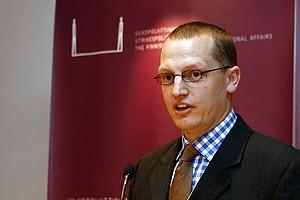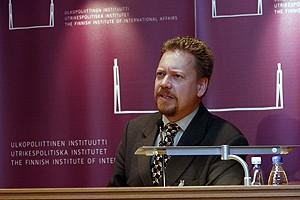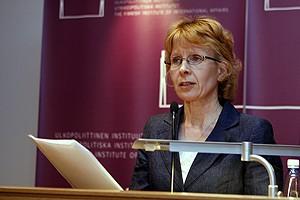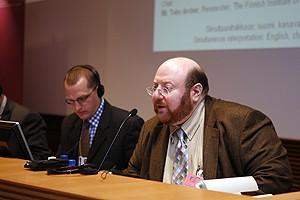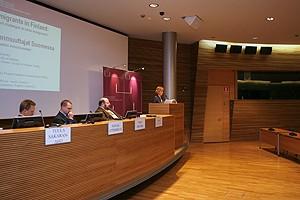On 21 May 2008 at 17:00-18:30
at the Auditorium of the New Annex Building of the Parliament (Arkadiankatu 3)
The European Union’s Strategy on Recruitment and Radicalisation requires from its member states certain policy- and decision-making that has direct implications for Muslim minorities in those countries. In Finland the majority of Muslims are either immigrants or children of immigrants, and so these sensitive issues are part of a wider discussion on integration of immigrants into the Finnish society. The aim of the seminar is to discuss the extent to which Muslim immigrants in Finland face different integration challenges to other immigrants and how these can be resolved. The seminar is also meant to give an opportunity for members of different Muslim communities to meet civil servants and other officials from the relevant fields..
Speakers:
Dr. Jonas Otterbeck, Malmö University
Prof. Tuula Sakaranaho
Comments:
Mr Anas Hajjar, Chairperson for Islamic Council of Finland (SINE)
Chair:
Mr. Toby Archer, Researcher, The Finnish Institute of International Affairs
Summary
EU policies require certain policy actions and information gathering that effect Muslim immigrants in all EU counties. Chairing the seminar, Toby Archer from the FIIA pointed out in his opening comments that relations between Muslim communities and the relevant state and local authorities in Finland are good, which is why seminars such as this need to be organised to allow dialogue and to ensure this positive situation continues.
The case of Sweden
Jonas Otterbeck
A new migration – Muslims have been on the soil of what we today call Europe since the early 8th century. Today, out of all 45 European countries, 19 have been at least partly under Muslim rule for at least a century. But today Muslims are not coming as conquerors or rulers, but as refugees, students, labour migrants or to join their families already at in Europe. So, even though Muslims have been in Europe for long, the new migration patterns are unique to our day and age.
Muslims in Sweden- In Sweden the number of individuals with a Muslim background is approximately 400,000. Sweden’s Muslim population comes from very diverse countries of origin, the biggest being Iran, Iraq and Bosnia. 25% of Muslims form parishes and get their religious activities supported by the state. Often this support is used to cover rental costs or costs for an imam or employed administrator. There is special support for example for women’s groups, adult education or imams visiting the sick or prison inmates.
The problems Muslims encounter are similar to those of other immigrants: for example getting your work experience and educational credentials translated. What is typical and special for Muslims is the perception of them as a group. One of the principal misconceptions about Muslims is that are perceived as a group, not a mere population with diverse interests. This presumption leads to an ‘ethnification’, in which religious belonging is given a socio-cultural meaning. This form of cultural racism has in the last decade been called Islamophobia.
The politics of recognition – For Muslims in Sweden, the recognition of the state is very important. The state tries to protect the individual from both direct and indirect discrimination. Religious freedom laws were abrogated in Sweden in 1999. There are now only general references to this freedom in the constitution and the laws protecting against discrimination.
The state is fairly efficient in trying to prevent discrimination against Muslims individually but it is not so keen on giving collective rights to Muslim groups. Muslims can act collectively to start schools, parishes or form interest groups only because any adult who abides by the general rules of society can do so. There is sufficient evidence to claim that the state can not protect the individual from discrimination in areas such as housing market and labour market.
The state has recently started to collect information about Islamophobia and has assigned Brottsförebyggande Rådet (The Crime Prevention Board) to gather and analyse statistics. The first results show that crimes motivated by Islamophobia exist to a certain extent in Sweden.
Becoming and Being Muslim – While humans are fairly easy to move, religions as a whole are not. It might be hard to perform one’s rituals in another culture where they can collide with everyday life. Also raising a child in another culture might lead to over-estimate the importance of one’s own views.
Muslim youth are tired of being stereotyped by the majority but also tired of the stereotypes of their parents about the majority society. They want to participate without hiding their faith and they want to be allowed to do that both by the majority and by their relatives or parish. Thus it is special to be a Muslim in Sweden. The youth are one of the first generations to grow up as a minority. There is a certain amount of discrimination and Islamophobia depending on faith and ethnicity.
Yet increasingly there is literature, music, journalism, and scholarly work being made by young Muslims and you find the some voices of young Muslims in politics and in the media. Muslim youth are, eager, skilled and hopeful about making a difference in the country they grow up in.
Muslims in Finland and Ireland
Tuula Sakaranaho
In Ireland, a large number of 35 000 Muslims work as medical doctors or run their own businesses. Thus, they are well-educated and know English language well. The Finnish Muslim population of 40 000 – 45 000 as a whole is not so well-positioned in society; Turkish Tatars who are more affluent are only a small group amongst Finnish Muslims (less than 800). The economic status has a direct bearing on the visibility and perhaps also on the influence that Muslims can have in our society.
Muslim values and family law – In Ireland Muslims have expressed their satisfaction with the way the state and society appreciates religion. In a sense Muslims among other small and new religious groups keep up the traditional Catholic values, which emphasise a woman’s chastity and value the family highly. Finland is much more secular than Ireland and religion does not play such a prominent role in society. However, Finnish legislation in respect of religious freedom is appreciated by the Muslim population.
Dressing code and rules – Islamic dress or hijab, which is worn by some Muslim women, has not become an issue in Finland and Ireland in the way it has in France and Germany. In Ireland, most Muslim parents do not demand that their girls wear the hijab at school but there has been some discussion on girls wearing hijab in Catholic schools.
In Finland, Muslim pupils are allowed to wear a head scarf in school, as are the female teachers. What has been discussed in Finland is the questions of safety; the hijab should not cause danger to girls in gym or in chemistry labs and so forth.
Wearing a hijab can be a problem in both of these countries if a woman wants to be employed, especially on public sector.
Education – In Ireland schools are founded in accordance with religious orientation and thus it has been rather easy for Muslims to start their own national schools. Muslim national schools follow the national Irish curriculum and are to a large extent funded by the Irish state. Moreover, the teachers are Irish except those teaching Arabic or Islam.
In Finland, the system of religious education has recently been reformed and Muslims among other religious minorities have a right to religious education of their own religion in school. Thus, Islam among other religions is taught in Finnish schools. There are, however, some problems in Islamic education that concern the lack of and education of teachers, the lack of study materials and so forth. But at least in the metropolitan area of Helsinki, Islamic education is quite well established.
From the municipalities’ point of view problems might occur if different Muslim groups start to demand Islamic education in their own form of Islam. We have in Finnish schools Lutheran, Orthodox and Catholic Christian education but only one form of education of Islam for both Sunni and Shi’a.
Media – In Ireland, the director of the Islamic Cultural Centre of Ireland is usually asked to comment in the media on issues related to Muslims. However, in Finland, it is usually a non-Muslim specialist from the university who gives statements concerning Islam. In this respect we in Finland have something to learn from Ireland.
Imams – The education of Imams has in recent years been an issue in Europe. Some European states want to take part in educating imams who understand European culture as well as their own religion. In Ireland there are at present three imams who have education as imams and there is no difficulty in Ireland to employ fulltime imams because the Islamic communities are wealthy enough to employ fulltime staff.
Employment – Since Muslims in Ireland are fairly well situated in society and have good networks on job markets they are also in a good position to employ newcomers, even if these would not have education or language skills.
In Finland, one of the serious obstacles for employment is the Finnish language. Earlier Muslim’s were employed in the field of trade. However, the problems started to occur in the 1990s when the numbers of Muslims and other immigrants and refugees started to grow and at the same time Finland was trying to recover from the economic recession.
Conclusion – It is very hard to make generalisations about Muslims in Finland or Ireland or in any other European country. They are a very heterogeneous group, if they can be called a group, regarding religion, culture, ethnicity, language, education and so forth. It is not a very fruitful to look at Muslims as one particular group in society. We should learn to see differences among them as well. At the same time, as long as Islam is seen by some to pose some sort of a threat to European societies, it is hard not to pay a special attention to a group called ‘Muslims’ in our midst.
Muslim immigrants and challanges in Finland
Anas Hajjar, Chairman of the Finnish Islamic Council
The first Muslims came to Finland in the middle of the 19th century and the first parish was established in the 1920s. First Muslims from Middle East arrived in 1960s but a bigger wave arrived in the 1980s and thus the Finnish Islamic Community was established in 1986. In the 1990s refugees from Somalia, Iraq and the former Yugoslavia arrived changing the character of the Muslim community in Finland.
Nowadays there are about 40000-50000 Muslims in Finland, out of which about 10% are registered in religious communities. The Finnish Islamic Council (SINE) was established in 2006 and registered in 2008. Currently it functions as an umbrella organisation for 17 associations. Associations and communities take care of various duties including for instance religious activities, social and cultural activities, and education.
Islam has maintained many features of the local cultures where Muslims come from. Therefore even if there are common features among all Muslims, every nationality has its own peculiarities.
Challenges facing Muslim immigrants in Finland include:
1. The values of Islam and Finnish law: inheritance law, lack of wills, collecting Zakat (tax for charity), circumcision of the boys, legal rights of unregistered Muslims and interest free loans, 2. Clothing tradition: in the past hijab wearing women had problems with the passport photo and although Islamic styles of dressing are now common in Helsinki they can be attention causing elsewhere in the country. 3. Teaching: There is a lack of qualified teachers and teaching material; also how Islam is taught to native Finns can be considered problematic. Obligatory swimming classes in high school have created many problems for girls wanting to wear more modest clothing than swimming suits. 4. Culture: lack of teachers in one’s mother tongue, lack of knowledge on Finnish culture and mixing Christian religious values in teaching can create misunderstandings. 5. Youth: how sex education is taught and in what age it is done has been an issues, as is preserving the identity of Muslim youths – there have been a lack of youth activities for young Muslims.
6. Media: this is perhaps the biggest challenge – how Islam is presented in media. Often only negative issues are brought up and rarely the positive ones. A Muslim is often described as scary and Islam is being spoken of in connection to words like fundamentalism or terrorism, which are not used while talking about other religions. Muslims have lacked sufficient information channels to the media.
7. Religion: there are two kindergartens but not any Islamic schools. Financing is the biggest challenge here. The lack of trained imams is also a challenge. 8. Politics: Muslims have participated in different parties for a long time and there has also been an attempt to establish an Islamic party but the opinions within the Muslim community vary greatly on that. Politicians need more knowledge about Islam, as well as Muslim immigrants needing to understand better Finnish politics. Immigrants are not participating enough in the politics of Finland, due to this lack of knowledge regarding candidates and the electoral system. Participating in politics is a way to protect against marginalisation. 9. Employment: Learning the language is a crucial factor in finding a job. Also approval of foreign degrees and qualifications in Finland is a problem and is associated with financial problems. Rejection solely on the basis of a foreign name does not usually take place in Finland if the language skills are sufficient and education has been acquired from Finland. 10. Cemeteries: there has been problems in finding suitable places for graveyards. Nowadays there is political will to find them and cooperation is happening with the church.
Q&A
The questions after the presentations discussed the role of the internet, future aspects of the role of all religions in Finland and different forums to cooperate with Muslims in Finland. In addition, the teaching of other religions in Muslim school books was asked about. One question enquired about differences in different European countries if the Muslim minority is dominated by one particular ethnic group, like in the case of Spain where most Muslims come from the Maghreb. Mr Otterbeck answered that there is an interesting link between leadership, ethnicity, language and interpretation of religion. In Sweden Muslims started to build umbrella organisations in 1975 in order to get money. Now there are four of them but there has been some conflicts between Sunni Arab, Turkish and Somali groups, as well as with Shias.
This action is part of the regional campaign ”1001 Actions for Dialogue” launched by the Anna Lindh Foundation the Dialogue between Cultures for the enhancement of peaceful coexistence and intercultural dialogue in the Euro-Mediterranean area. The action was generated with the financial support of the Anna Lindh Foundation.
